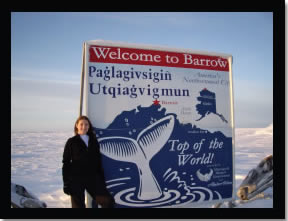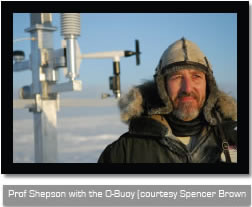Oasis 2009

OASIS (Ocean-Atmosphere-Sea Ice-Snowpack) was a large collaborative field campaign aimed at studying the chemical and physical interactions that occur between the atmosphere and cryosphere after polar sunrise. Scientists from many institutions, including Purdue University, Georgia Institute of Technology, Villanova University, Environment Canada, National Center for Atmospheric Research, Laboratoire de Glaciologie et Geophysique, and the University of Heidelberg, traveled to Barrow, AK, for the two month study.
Atmosphere-cryosphere interactions are complex and have large impacts on the chemistry and composition of the lower troposphere. The snowpack itself can act as a large photochemical reaction chamber, oxidizing and transforming some chemical species, while producing and emitting others. Many of these were measured during OASIS, including reactive and molecular halogens, and elemental and reactive mercury, ozone, OH and HOx, NOx, and numerous VOCs.
Halogens are a critical factor in the chemistry of the Arctic troposphere. Because the water content of the air is so low, OH radicals (primary atmospheric oxidant) are also low, and Cl and Br atoms derived from sea salt become the primary oxidants. After polar sunrise, photochemically driven reactions involving mostly bromine, initiate so-called “ozone depletion events” (ODEs), the episodic destruction of ground-level ozone from ~40 ppbv to near zero. Analogous depletions in gaseous elemental mercury are also attributed to this bromine reactivity. Chlorine is especially important for oxidizing VOCs in this environment and potentially for perpetuating the bromine cycle via production of HOx.
One of the roles of the Shepson Group during OASIS was to conduct measurements of BrO and ClO radicals using a flowing chemical reaction method developed in-house (see details here). Former group members Chelsea Stephens, Phil Tackett, and Adam Keil, set up instrumentation at the KBRW radio tower site, approximately 14 km south of Point Barrow. The flowtube was housed inside of a heated wooden box mounted to the roof of the building and a heated sample line carried the reaction products inside the building to the GC-ECD. The measurement system was automated for this field study, allowing continuous sampling through the day and night.
ClO was successfully measured via this method throughout the campaign. This was the first time that in-situ chemical measurements of this species had ever been achieved. Peaks up to 12 pptv were measured, with average mixing ratios between 2-4 pptv. The chemistry at Barrow proved to be highly active in regard to chlorine, which came as a surprise. Previous estimates of chlorine concentrations given in the literature were very low, and chlorine was believed to be only a minor player in ODE-related chemistry. One of the major successes of this campaign was that we have first-time measurements of both molecular chlorine (by Georgia Institute of Technology) and chlorine monoxide radicals. Cl2 concentrations reached as high as 400 pptv! This has forced us to take a new look at the role of chlorine in Arctic chemistry.

Former Shepson Group member Travis Knepp also participated in the OASIS campaign as a part of the O-Buoy project. The O-Buoys are a collaborative project between Purdue, the University of Alaska Fairbanks, Bigelow Laboratories, and the US Army Cold Regions Research and Engineering Lab.
Because the Arctic polar ice cap is a remote and unforgiving environment, constant atmospheric monitoring at manned stations is precluded. As a result, there has been no ground-level data from within the Arctic Basin. The O-Buoys were designed to be a system of autonomous, ice-tethered buoys that measure ozone, halogens, CO2, and a suite of meteorological parameters. These data are sent back via iridium satellite.
During OASIS, the first O-Buoy was installed in the sea ice at Elson Lagoon for proof-of-concept testing. After this successful test, two more buoys were deployed into the Arctic Ocean and one more in the Hudson Bay.
The O-Buoy project was funded in 2010 to build 12 more buoys through 2015. The goal is to create an Arctic Ocean wide network to continuously monitor the chemistry and meteorology associated with ODEs.
You can see photos from OASIS here.
An OASIS History
The OASIS (“Ocean-Atmospher-Sea Ice-Snowpack”) program was created in response to a challenge, by OPP staff, to the Arctic research community to create a research program that integrates scientific issues related to interactions involving the Arctic Ocean, the overlying sea ice and associated snowpack, and the atmosphere, in the context of a changing climate. The response to this challenge was inspired by a number of recent observations by the Arctic atmospheric science community that implied a range of complex Arctic System-wide phenomena that influence Arctic atmospheric composition (and thus potentially climate) but that were apparently driven by or connected to the nature of the surface. Among these observations are:
- The Arctic region atmosphere is plagued by “Arctic Haze”, i.e. visibility-reducing aerosol particles, a phenomenon that seems to occur in a time frame of ~March – May, i.e. when there is sunlight, but a cold, stable atmosphere above a largely frozen surface.
- Widespread depletion of ozone, from the surface to as high as 1-2km, throughout this same period. Ozone can be >99% removed, for extended periods.
- Depletion of elemental mercury, and otherwise long-lived gas, and deposition of the mercury oxidation products to the surface, where they may impact the biota.
- A decreasing areal extent of sea ice in the Arctic Ocean region.
These phenomena are linked to or impacted by climate change. Arctic Haze is important to understand, as the sea-ice albedo feedback depends in a significant way on how cloud cover will change with more open water in the Arctic Ocean region. That depends in part on the presence of cloud condensation nuclei (CCN), and the sulfate aerosol particles characterized by Arctic Haze are likely very good CCN. The extent to which Arctic Haze is mediated by springtime halogen chemistry is unknown, but it is likely that there is a substantial impact. Ozone and mercury depletion appear to be mediated by processes occurring above sea ice; thus as sea ice retreats, and the overlying atmosphere becomes more unstable, these processes will diminish. While that may well decrease mercury deposition into the Arctic, it will most certainly lead to increases in the surface ozone concentration in the spring. The consequences of dramatic increases in the concentration of this biosphere toxin at the time that the biosphere reawakens in the spring are not known.
To discuss what the major unknowns are, and how the community might organize to best pursue the science, a workshop was funded by OPP (0220627-OPP) and held at Purdue University, November 12-14, 2002. It was attended by 24 researchers chosen to represent a breadth of subject matter and expertise across the spheres of Arctic research, i.e. atmospheric chemistry, meteorology and climatology, toxic substances and transport, ice and snow physics, marine biology, and oceanography. A final Workshop Report was delivered to NSF in November of 2003. In that report, it is stated that “the workshop participants recommended development of a new coordinated and collaborative interdisciplinary effort aimed at improving our understanding of atmosphere-surface chemical exchange in the Arctic and its impacts”. The name OASIS was proposed at that time. The Workshop Report outlined a tentative project scope and set of foci, but recommended that, as next steps, an EOS article summarizing the outcome of the workshop be published, followed by development of a Science Plan. In 2003, the following paper was published in EOS:
P. Shepson, P. Matrai, L. Barrie, and J. Bottenheim, Ocean-Atmosphere-Sea Ice-Snowpack Interactions in the Arctic, and Global Change, EOS Transactions, 84, 349, 2003. Link to article
At the March 2004 All-Hands meeting, Paul Shepson presented a summary of the Developing OASIS Science Plan. At that meeting it was decided that Lou Codispoti and Don Perovich would draft a letter expressing the OAII SSC’s support of OASIS to be submitted to Neil Swanberg and Jonathan Overpeck (then Chair of the ARCSS Committee). The Science Plan was completed in December of 2004 after extensive open vetting by the community via the web. In March 2005, Paty Matrai presented a summary of the OASIS development to date to the ARCSS SC as a possible CoP. This was followed by a community open workshop conducted in January of 2006 in Rome, Italy, sponsored by CNR-Rome. The workshop was attended by 42 participants, and led to development of a draft Implementation Plan. OASIS has since evolved into the Cryosphere and Atmospheric CHemistry mission. The data from the OASIS field work can be found in this database. Since the time of the Rome workshop, CNR-Rome has sponsored a Coordinating office, led by the OASIS Coordinator, Dr. Harry Beine. From the Implementation Plan a proposal was drafted for the IPY project OASIS-IPY. That proposal was ultimately approved by the ICSU-WMO process as an IPY Project.
